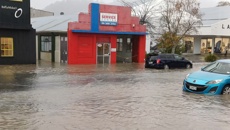Scientists have used artificial intelligence to show how two recent bouts of unrest at Whakaari/White Island – including 2019′s tragic eruption – came with similar trigger mechanisms.
The team behind the new data-driven model ultimately hope it can be used to track and detect tell-tale changes in New Zealand’s volcanoes before they blow.
Their model is built on large volumes of seismic data – capturing the tiniest of vibrations – that GeoNet sensors continually collect around our volcanoes.
But because that data happened to be a tangle of different seismic signals – from those caused by volcanic quakes and gases, to the effects of wind and rain – picking them apart to get a clearer picture wasn’t simple.
As part of an MBIE-funded project, University of Auckland researcher Bastian Steinke and colleagues turned to machine-learning to sort these signals into set clusters.
“In theory, if a volcano is in one specific state of activity, like pressure building up, we will observe a different class of seismicity than if the volcano was in a different state,” Steinke explained.
“We can use this information to infer possible underlying dominant process, in order to keep track of the current state of a volcanic system.”
While the project was focused on Mt Taranaki – which has a roughly 50 per cent probability of blowing in the next 50 years – Steinke and colleagues opted to test their AI-powered “classifier” on our rowdiest volcano, Whakaari/White Island.
That was because of the rich, long-running datasets provided by its local seismic stations – but also the wide range of activity observed there over episodes in 2012-13, 2016 and 2019.
“Volcanic activity within this period includes relatively light to moderate activity, such as minor emission of ash and gas, but also more violent events such as hydrothermal explosions,” Steinke said.
The latter – which occurred with the 2019 eruption that left 22 people dead – often came with subtle precursors that couldn’t always be picked up with current approaches.
“Hence, there is need for developing new techniques to detect precursors, especially to hazardous steam-driven events.”
A still taken from a tourist boat when Whakaari/White Island erupted in December 2019. Photo / Supplied
As described in a newly-published study, the model was able to find such seismic pre-signals with two of those recent spells of unrest at Whakaari/White Island.
In the first instance, the model picked up a change in seismicity a few weeks before an eruption there in 2012, and which appeared to coincide with the system “sealing” itself up.
“There is always space for interpretation, and most changes cannot be attributed to solely one underlying source process,” Steinke said.
But the more data the team fed into the classifier, the better they were able to compare different episodes of increased activity with each other.
Steinke and colleagues Dr David Dempsey and Professor Shane Cronin suspected the shifts to more active volcanic states at Whakaari could be linked to different “pressurisation” processes within the volcano.
“We also found similarities between some of the regimes associated with system pressurisation during the 2012/13 and the 2019 eruptive events, alongside with some differences regarding durations and specific sequences of individual regimes,” Steinke said.
“This is something that helps us to understand what happens during the stages building-up to an eruption - and also why one eruption was maybe similar or different to another.”
In contrast, the model didn’t pick up such a change in the lead-up to a steam-driven eruption in April 2016 – but Steinke didn’t count that as a negative.
“It’s interesting for us to see when the algorithm does not work, because it is a valuable indication that something is different to what we have seen before.”
Looking ahead, Steinke said the approach could be promising for warning of looming eruptions, in New Zealand and elsewhere.
“Our initial approach is for long-term tracking of volcanic activity over years or decades, which helps to put short term changes into perspective,” he said.
“This would also assist other forecasting systems that are more focused on short-term changes, as it could help reduce the number of false alarms.”
The study wasn’t the only instance of scientists searching for seismic hints at Whakaari/White Island.
In another recent paper, University of Canterbury geophysicist Dr Alberto Ardid reported how another machine learning-based model turned up similar signals in the lead-up to the 2019 disaster – but also to eruptions at several other volcanoes.
“These frequency transitions allow us to listen in on what’s happening at different depths under the volcano,” Ardid told the Herald last year.
“Watching closely for this pattern could provide an early warning of future eruptions.”
New Zealand’s current volcano monitoring, run by the GeoNet project, draws on a range of indicators, including geochemistry, remote sensing, geodesy and seismic data.
At the time Ardid’s paper was published, GNS Science natural hazards and risks research leader Dr Jill Jolly said she and colleagues were “excited by the results and the way that they are using GeoNet’s seismic data”.
“This new modelling can be considered together with analysis of the full range of multi-disciplinary data that helps us understand volcanic unrest.
“There are a number of research projects underway looking at precursors to phreatic eruptions, which will all hopefully feed into our volcano monitoring toolbox in future.”
Take your Radio, Podcasts and Music with you









